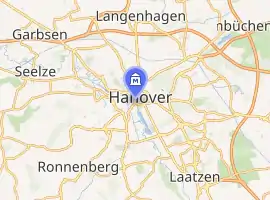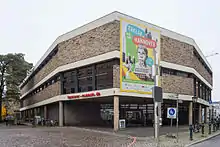Historisches Museum Hannover
Historisches Museum Hannover is a historical museum Hanover, Lower Saxony, Germany, founded in 1903 as Vaterländisches Museum der Stadt Hannover. Its collections are related to the history of the city, the history of the governing House of Welf, and of the state of Lower Saxony.
 | |

| |
| Established | 1903 |
|---|---|
| Location | Hanover, Lower Saxony, Germany |
| Coordinates | |
| Type | Historical museum |
| Director | Thomas Schwark |
| Website | www |
History

Postcard 1, Series B; Georg Alpers jun.
The museum, run by the city of Hanover, was opened on 26 April 1903 as Vaterländisches Museum in the Cumberlandsche Galerie.[1] The foundation took place on the initiative of the Heimatbund Niedersachsen.[2] In 1937 the museum was renamed as Niedersächsisches Volkstumsmuseum. It was destroyed in 1943 by the Bombing of Hanover in World War II. From 1950 the provisional reconstruction began under the temporary name of Niedersächsisches Heimatmuseum. In 1966 the museum was opened under its present name in a new building designed by the architect Dieter Oesterlen. The "Verein der Freunde des Historischen Museums" supports the work of the museum financially and ideally.
In 2017, the museum's permanent exhibition, conceived in 1993, was redesigned.[3] In 2020 the museum closes for three years for renovation work.[4]
Location

The headquarters of the museum is located Am Hohen Ufer on the Leine river, where the beginning of the medieval settlement of Hanover in the 11th century is assumed, near a Leine crossing of the road between Hildesheim and Bremen, which was secured here by a fiefdom. Even if the derivation of the city's name "Hanovere" or "Honovere" from the "high bank" should not be correct according to the latest scientific findings, the museum has a unique location in the area of the city's origin.
The Beginenturm integrated into the museum is the last completely preserved tower of the medieval fortifications of Hannover. The museum building also incorporates a high stone wall of the ducal Zeughaus am Hohen Ufer, built between 1643 and 1649. The wall facing the Hohes Ufer is a section of the city wall. In 2013, when significant medieval finds were discovered in the area during construction work on a neighbouring plot, it led to a three-months archaeological investigation. Opposite of the museum is the historic old town of Hanover which was completely destroyed in World War II, with Burgstraße featuring numerous half-timbered houses reconstructed in the 1960s, as well as the restored Leibniz House on Holzmarkt.
Building

The museum building was constructed as a new building from 1964 to 1967 according to the plans of the architect Dieter Oesterlen. The Beginenturm and the rest of the ducal arsenal were included on the site of a block of flats in the old town development destroyed in the war. The museum has a polygonal ground plan around a pentagonal inner courtyard. The striking façade has three storeys with alternating broad sandstone surfaces and narrow bands of windows and a staggered view from the northern Burgstrasse. In 1991 it was rebuilt and in 2002 the individual departments were redesigned. This concerned the department of regional history on the ground floor and a part of the city history on the first floor.
The text of the illuminated quotation by Gottfried Wilhelm Leibniz on the Leibnizufer - a light installation by the American conceptual artist Joseph Kosuth[5] – reads:
There is no desert, nothing infertile, nothing dead in the world, no chaos, no confusion, except an apparent one, something like what you would see in a pond if you saw a confused movement and a swarm of fish from some distance, without distinguishing the fish themselves
— Gottfried Wilhelm Leibniz
Collections
Departments
The museum is divided in four departments:
- Vom Fürstentum zum Königreich (From principality to kingdom), showing the development from the Principality of Calenberg around 1600 to the end of the Kingdom of Hanover in 1866
- Vom Marktflecken zur Messestadt (From market village to trade fair city), showing how Hanover developed within 750 years from a settlement to den hogen overen (on the high banks) to a city
- Leben auf dem Lande (Life in the country), showing how the rural population of Lower Saxony lived from the 17th to the 20th centuries
- Museum Schloss Herrenhausen (Museum Herrenhausen Palace), located at Schloss Herrenhausen and opened in May 2013 as a new department
Photo archives
The museum is one of the largest photo archives in Germany: it already holds around 1,000,000 historical photographs for consultation and the acquisition of reproductions.[6] According to photo heritage, the museum has a stock of more than 5.000.000 photos.[7]
Decorations and orders
The politician and banker August Basse donated the so-called Finkam Collection of Orders and decorations to the Vaterländisches Museum.[8][9]
Vehicles

Some vintage vehicles are on display in the museum, such as a Hawa 40 Volt Elektro-Kleinwagen from the Hannoversche Waggonfabrik.
People

From 1928 to 1945, Wilhelm Peßler was director of the Vaterländisches Museum in Hanover. Waldemar R. Röhrbein was director from 1976 to 1997, succeeded by Thomas Schwark.
Further reading
- Historisches Museum Hannover. In Dieter Oesterlen: Bauten und Texte 1946-1991. Tübingen: Wasmuth 1992, pp. 138–147. ISBN 3-8030-0153-6.
- Waldemar R. Röhrbein: Historisches Museum am Hohen Ufer 1903 – 1978.[10] In Hannoversche Geschichtsblätter, Neue Folge 32 (1978), pp. 3–60
- Franz Rudolf Zankl: Ausstellung der Gildealtertümer im Vaterländischen Museum. Fotografie um 1910. In Hannover Archiv, Blatt K 12
- Helmuth Plath: Stadtgeschichtliche Abteilung.[11] (Abteilungskataloge des Historischen Museums am Hohen Ufer, Hannover. 1). Hanover 1970.
- Mit Geschichte in die Zukunft, Festschrift zum 25-jährigen Bestehen der Freunde des Historischen Museums, Hannover 2005
- Helmut Knocke, Hugo Thielen: Pferdestraße 6. In Hannover Kunst- und Kultur-Lexikon, pp. 178–180
- Thomas Schwark, Waldemar R. Röhrbein: Historisches Museum In Klaus Mlynek, Waldemar R. Röhrbein (ed.) among others: Stadtlexikon Hannover. Von den Anfängen bis in die Gegenwart. Schlütersche, Hanover 2009, ISBN 978-3-89993-662-9, p. 299.
References
- Thomas Schwark, Waldemar R. Röhrbein: Historisches Museum. In Stadtlexikon Hannover, p. 299
- "Geschichte Heimatbund".
- So wird das Historische Museum umgebaut in Hannoversche Allgemeine Zeitung 24 November 2017
- Suche nach Magazin: Wo sollen Hannovers Schätze lagern? in Hannoversche Allgemeine Zeitung 23 December 2019
- Leibniz Universität Hannover: Leibniz und Hannover – dem Universalgenie auf der Spur, 2. geänd. Aufl.
- Online-Darstellung, Punkt 8, retrieved 4 August 2020
- Rohde-Enslin, Dr Stefan. "fotoerbe.de - Bestände in Hannover". www.fotoerbe.de.
- Waldemar R. Röhrbein: BASSE, (1) Wilhelm. In Dirk Böttcher, Klaus Mlynek, Waldemar R. Röhrbein, Hugo Thielen: Hannoversches Biographisches Lexikon. Von den Anfängen bis in die Gegenwart. Schlütersche, Hannover 2002, ISBN 3-87706-706-9, p. 43; online on Google Books
- Vergleiche August Finkam: Die an Braunschweiger und Hannoveraner verliehenen Ehrenzeichen für Krieg, Verdienst und Dienstalter, Lafaire, Hannover 1901
- Fünfundsiebzig Jahre Historisches Museum am Hohen Ufer, Hannover : 1903-1978 on WorldCat
- Stadtgeschichtliche Abteilung on WorldCat
External links
| Wikimedia Commons has media related to Historisches Museum Hannover. |
